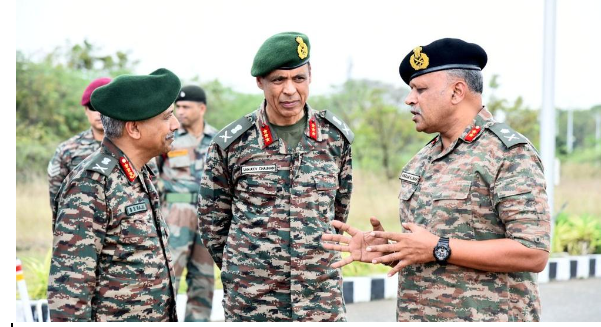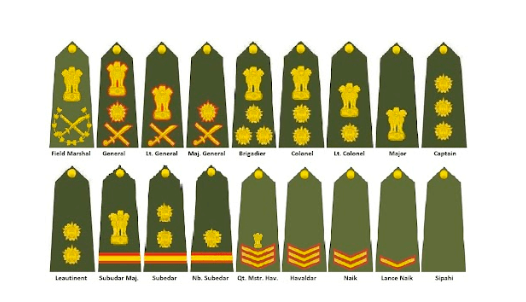The Indian Army has decided that from 1st August 2023, all officers of the rank of Brigadier and above will wear Common Uniform items irrespective of their cadre and appointment, in order to promote and strengthen common identity and approach.
What is the Uniform of Senior Indian Army Officers?
Current Position:
- Different branches of the Indian Army wear different uniform accouterments, such as berets, lanyards, and badges of rank, based on their regimental or corps affiliation.
- Accouterments are additional items of dress or equipment that are worn or carried, especially by military personnel, to complete a uniform or outfit.
- Infantry officers and Military Intelligence officers wear dark green berets, armored corps officers wear black berets, and other corps officers wear dark blue berets. Officers from the Corps of Military Police wear red berets.
- As of now, all officers from the rank of Lieutenant to General wear uniform accouterments as per their regimental or corps affiliation.
New Uniform:
- All officers of the rank of Brigadier, Major General, Lt. General, and General will now wear berets (caps) of the same colour, common badges of rank, a common belt buckle, and a common pattern of shoes.
- The shoulder rank badges will be golden for all senior officers.
- As of now, officers from the rifle regiments such as Gorkha Rifles, Garhwal Rifles, and Rajputana Rifles wear black rank badges.
- The headgear, shoulder rank badges, gorget patches, belts, and shoes of senior officers of Brigadier and above ranks will now be standardized and common.
- There is no change to the uniform worn by Colonels and below-rank officers.
- They will no longer wear regimental lanyards (cords) on their shoulders. They will also not wear any shoulder flashes like ‘Special Forces’, ‘Arunachal Scouts’, ‘Dogra Scouts’, etc.
- Thus, there will be no item of uniform that will identify them as belonging to a particular Regiment or Corps. All officers of these higher ranks will dress alike in the same pattern of uniform.
What is the Significance of this Decision?
- This decision will help to promote a more cohesive and integrated organizational culture within the Indian Army.
- A standard uniform will ensure a common identity for all senior-rank officers, while reflecting the true ethos of the Indian Army.
- By eliminating regimental parochialism, senior officers may be better able to meet the challenges of modern warfare and adapt to changing strategic circumstances.
- Regimental Parochialism refers to loyalty towards one’s regiment or corps. It is a sense of pride and attachment to one’s unit that can sometimes lead to a lack of cooperation or competition with other units within the same organization.
- It may also improve the ability of senior officers to command troops of mixed regimental lineage.
- By presenting a neutral uniform rather than a regimental one, senior officers may be able to establish a more inclusive and collaborative leadership style that transcends traditional loyalties and affiliations.
What is the Tradition in Other Armies?
In the British army, from where the Indian Army derives its uniform pattern and associated heraldry, the uniform worn by officers of the rank of Colonel and above is referred to as the Staff uniform, to distinguish it from the Regimental uniform. The wearing of any item of Regimental uniform, particularly a headdress, with the Staff uniform is not authorized.
Among neighboring countries, the Pakistan and Bangladesh armies follow the same pattern as the British army.
- All regimental uniform items are discarded beyond the rank of Lt Colonel.
- All officers of the rank of Brigadier and above wear similar pattern uniforms.
Ranks in the Indian Army
Indian Army ranks represent the hierarchical structure and organization of the Indian Army. These ranks signify the levels of authority, responsibility, and leadership within the military. The Field Marshal holds the highest rank in the Indian Army. Understanding the Indian Army ranks is essential for comprehending the organization’s chain of command, promotions, and career progression.
Indian Army Ranks
The Indian Army follows a well-defined rank structure, which includes commissioned, non-commissioned, and junior commissioned officers. Each rank carries specific duties, responsibilities, and insignia that distinguish individuals within the military hierarchy. These ranks serve as a symbol of authority, leadership, and expertise within the Indian Army, defining the hierarchy and command structure that upholds the nation’s defense and security.
After India gained independence in 1947, the Indian Army underwent significant changes, including the restructuring of its rank system. In 1950, a new set of ranks was introduced to reflect the independent status of the Indian Army. Let us explore each in detail in the coming sections.
|
Commissioned Officers: Ranks & Insignia in Indian Army |
|
|
Commissioned Officers |
Insignia |
| Field Marshal | National emblem over a crossed sword and baton in a lotus blossom wreath. |
| General | Crossed sword and baton with star and national emblem. |
| Lieutenant general | Crossed sword and baton with national emblem above. |
| Major general | Crossed sword and baton with the star above |
| Brigadier | Three stars in a triangle and National Emblem above |
| Colonel | Two stars and the national emblem above |
| Lieutenant Colonel | One Star and National Emblem above |
| Major | National Emblem |
| Captain | Three stars in one line |
| Lieutenant | Two stars in one line |


